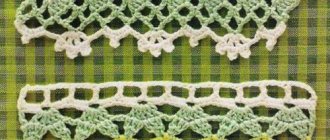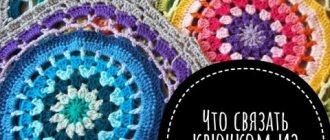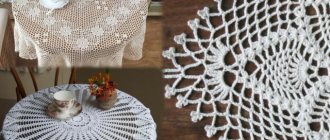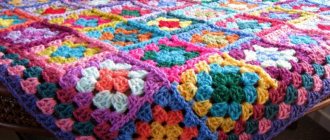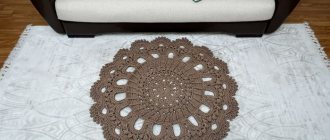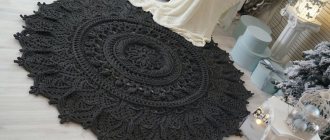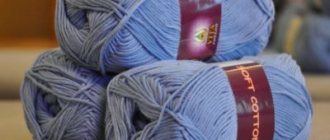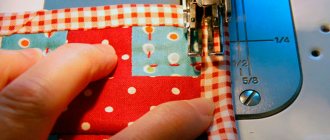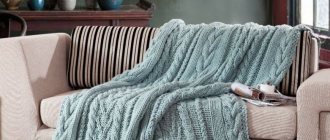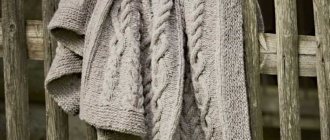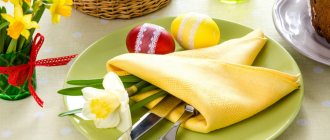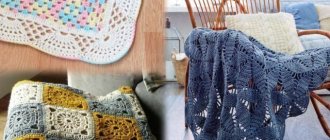In the modern world, you can buy almost any product, but things made with your own hands have true value. Crocheting is a technique with which any housewife and needlewoman can convey her care and love, and it is also an excellent way of self-expression.
Can you crochet? Publish your work on kru4ok.ru
This technique is distinguished from all others by the speed of knitting and the ability to create very beautiful openwork fabrics that resemble light, airy lace.
From early childhood, undoubtedly, everyone associates crocheted tablecloths with warmth and care. They are pleasant to the touch and look very elegant and elegant. Tablecloths knitted by yourself will create an atmosphere of warmth, comfort and festivity in absolutely any interior, and can also become an original gift for your loved ones or serve as a wonderful decoration on a common table.
The process of knitting is very exciting, useful for fine motor skills and has a calming effect. And, most importantly, only from the outside, knitting seems like a time-consuming and difficult task, but you just have to try it, and you will see for yourself that in reality, with the right approach, crocheting tablecloths is not difficult even for beginners and very young needlewomen.
Our diagrams will help you see this! With desire and diligence, very soon you will be able to repeat the most complex patterns, as well as surprise others with works with your own unique patterns.
Selection of material and tools
Yarn and tools for work are selected based on the purpose of the finished product. Traditionally, tablecloths are knitted from cotton thread. For a classic tablecloth, the ideal option is plain mercerized cotton with a thread thickness of 400 to 600 m per 100 g.
Metal hooks of different sizes are suitable for working with this yarn. The diameter of the tool is selected individually, focusing on the specific knitting density and the recommendations of the yarn manufacturer (they are indicated on the labels).
For example, for a thread with a thickness of 400 m/100 g, hooks from No. 1 to 2.5 are suitable. Fine yarn with a yardage of 600 m/100 g can be knitted using hooks No. 0.5; 0.9; 1.25 or even 1.5 and 2.
Choose a crochet hook based on the recommendations for knitting a particular product
The thinner the hook, the denser the canvas will be, and vice versa: the larger the caliber of the tool, the looser and softer the tablecloth will be. The sample should be measured only after WHT (wet heat treatment).
Cotton tends to shrink after washing, so only a completely dry sample will allow you to get real numbers for calculations. As an alternative to cotton, you can choose other yarn compositions, for example, viscose, bamboo, linen, silk or mixed types of materials.
A crocheted tablecloth for a rectangular table will be practical and durable if you knit it from synthetic thread (polyamide, microfiber). Such materials are easily washed from dirt and keep their shape. However, you should not use acrylic, as it can stretch, fluff and lose its attractive appearance over time.
The same recommendations will help you choose yarn for a tablecloth in a modern style, with the difference that there is greater freedom in choosing colors and textures. The total material consumption for a specific product can only be determined after weighing the sample. You need to calculate the area of the sample, compare it with the area of the future tablecloth and then calculate the amount of yarn.
Before knitting a tablecloth, knit a small sample - this will help calculate the amount of yarn required for knitting
For example: the sample has an area of 10x10 cm (100 cm2) and weighs 5 g, and the finished product should be 180 cm long and 160 cm wide (28800 cm2). If you divide the area of the tablecloth by the area of the sample, it turns out that the finished product will “fit” 288 samples of 5 g each. So, to knit a tablecloth you will need 1440 g of yarn (provided that the density of the craftswoman remains the same as when knitting the sample) .
Technique for crocheting a rectangular tablecloth on a table
Tablecloths with an openwork border, assembled from motifs, made with a fillet pattern, or with additional embroidery are considered classic. Usually these are plain products made from natural material.
A crocheted tablecloth for a rectangular table can also be more modern. In this case, it should have a completely different look: a minimum of patterns and a laconic design, bright colors (although simple basic shades are often used), a small number of openwork holes.
All possible options for making a rectangular tablecloth can be combined into 3 large groups:
- Knitting a whole fabric.
- Combination of individual motifs.
- Formation of the central zone and binding of the border.
Making a tablecloth using the first method will be the easiest; it is ideal for beginner knitters. They may experience some difficulties at the very beginning of work, since the first rows will be very long.
The advantages of the technique are that the size of the finished product is immediately visible, it can be measured and, if necessary, adjustments can be made. The first type of tablecloths includes products made with various meshes, simple patterns, as well as models using the fillet technique.
Fillet patterns are a combination of empty (double crochet, 1 chain crochet) and filled squares (2 double crochets). A tablecloth is crocheted quickly for a rectangular table using the fillet knitting technique. There are many different patterns.
Crochet tablecloth: knitting patterns for loin patterns
Some of them are a repeat of 10-30 loops and rows, which must be repeated to get a large fabric. Others include an ornament for an entire product and can number several hundred loops and rows. You can adapt monochrome embroidery patterns to knit an unusual and original tablecloth using the fillet knitting technique.
The second method of knitting tablecloths is one of the most popular, since it is easiest to assemble a rectangular tablecloth from square motifs. But there are other options: circles of different sizes, triangles, hexagons, octagons, stripes and irregularly shaped elements.
If the tablecloth is assembled from round modules, then choose motifs of 2 sizes. The main canvas consists of large circles, and the gaps are filled with small elements. When working with non-standard shapes, you need to think in advance about what shape the finished canvas will receive.
To form perfectly smooth edges and corners, it is often necessary to tie together halves and quarters of modules. Knitting a tablecloth from abstract motifs requires experience, perseverance, good spatial imagination and time.
Crochet rectangular tablecloth: knitting patterns for square motifs
Since the motifs are made separately, each has a minimum of 2 tips. They need to be securely hidden at the end of the work so that the canvas looks solid and neat.
Many experienced craftsmen recommend using a needle for these purposes, rather than hiding the threads inside the crochet posts. If the ends of the threads are not hidden securely enough, they will quickly appear on the surface of the tablecloth after the first wash.
Do not burn the tails of cut yarn. If we are talking about the natural composition of the material, then it will not melt, but will burn. However, even synthetic thread should not be burned, since the melted ball will stand out on the canvas in color and texture (you will get a hard black lump).
Combining motifs into a single piece is an important point. There are several ways to assemble modules into a tablecloth: sew separately connected elements with a needle, use a crochet hook for the same purpose, or connect the motifs when knitting the last row.
A tablecloth can also be crocheted from round motifs.
You can stitch modules with a needle or crochet only when their last row has a clear outline or is a straight line. For example, straight edges of a square, hexagon or octagon. All edges are the same size and are easy to match and stitch.
First, the finished motifs are laid out on a flat horizontal surface with the wrong side up, adjacent elements are pinned together and then sewn together. The most convenient way is to sew the motifs into stripes, and then connect them together. At the final stage, the seams on the finished tablecloth are ironed from the inside out or simply doused with steam.
To connect the motifs while knitting the last row, you should choose patterns that end with a picot. This element (loop) consists of 3 air loops having one base.
To combine 2 motifs, you need to knit the 1st completely, and attach the 2nd to the first as follows:
- knit the 1st picot loop;
- insert the hook into the picot of the 2nd motif and make a connecting stitch;
- complete picot knitting on the 1st motif (make the 3rd loop).
It is important to ensure the correct arrangement of the tablecloth elements so that all the “picots” are connected in pairs.
Sample
All products made from patterns slightly change the rules regarding the pattern. Since quite often it is one pattern that is a sample of the whole work. Then the calculation takes place not for 10 cm and an element for them. You can also calculate by the size of the finished element.
Set of first crochet stitches
For example, the piece turned out to be 10 by 10 cm in size, and you need to make a product that is 100 by 100 square. Accordingly, you need to take 10 options for each side. In total, you will need to knit a hundred things for such a product.
Sizes and shapes
A crocheted tablecloth for a rectangular table should also have the shape of a rectangle, but its edges may be uneven. This happens when the canvas consists of round or polygonal motifs and there are no small elements to align the contour. Uneven edges are not considered a mistake, because there is no standard or ideal sample.
Tablecloths made from square motifs or knitted in a single fabric have clear contours. The edge is obtained neatly as a result of tying the finished product with several circular rows of single crochets. Then an openwork border is added or the simplest binding is left.
The product looks beautiful and appropriate only when it completely covers the table and hangs from its edges to a sufficient height (from 20 to 40 cm).
When calculating the length and width of the tablecloth, it is necessary to add the length of the overhang, multiplied by 2, to the corresponding parameters of the table.
If the finished product will have very uneven edges, it is better to include longer overhangs in its size. In the case when all edges of the product will be decorated with a fringe of tassels, spirals or other long decor, it should be added to the total length of the overhang (so that the fringe does not start at the tabletop itself).
If the finished tablecloth is not large enough for a rectangular table, it can be turned at an angle of 90 degrees and laid on top of another (textile) tablecloth. This technique works best with square canvases.
Square motifs
Tablecloths are not only large, but also mini - a small tablecloth that looks more like a napkin. It would be a great option for a coffee table or small dining table. You can also create it in any color.
We will need:
- Cotton yarn;
- Hook.
Product size - 75x75 centimeters.
This wonderful tablecloth is knitted from nine square motifs 3x3 centimeters in a dense knitting pattern. Then you need to connect them into one ring. More detailed knitting is shown in the diagram below.
Related article: DIY plywood Christmas tree
The finished tablecloth needs to be tied with an openwork border.
How to read diagrams correctly
Depending on the type of tablecloth chosen, the graphic scheme may include 1 or several repeats (elements that need to be repeated in width and height), a separate motif (round, square or polygonal) or a schematic image of the entire product.
Large patterns for the entire tablecloth are rare; they are usually drawn up for large-scale patterns using the fillet technique or in cases where a combination of several simpler patterns is being designed. Schemes of modules and simple patterns are much more common.
To work with graphic images of patterns, you need a key (decoding the symbols). It is attached to the diagram and contains a verbal explanation of the symbols used. Different designers can use both generally accepted symbols and their own unique icons.
Patterns compiled for knitting in straight and rotary rows read as follows:
| Row numbering | Knitting feature |
| 0th row | Chain chain of air loops |
| 1st and every odd | From right to left |
| 2nd and every even | From left to right |
The numbering is located to the right and left of the diagram. In circular motif patterns, each row is also numbered, but the numbers are located inside the pattern near the beginning of each row. Circular rows begin with lifting loops (1, 2, 3 and more) and always end with a connecting column. This makes the rows look neat and complete.
How to knit a tablecloth from motifs
The process of creating a large product from individual modules can be divided into the following stages:
- Measuring the table, calculating the size of the future tablecloth in centimeters.
- Choice of yarn and hook.
- Knitting one motif, washing it, drying it, measuring it.
- Calculation of the number of motifs that will make up the tablecloth. It is important to take into account the width of the border if it is planned for a specific product.
- Consistent knitting of all motifs, their connection.
- Working with thread tails.
- Tablecloth binding.
- Wash, dry, iron or steam.
It is necessary to hide the tails of the threads before performing an HTO, then they will be securely fixed in the desired position. Do not steam or iron the product in parts.
It is best to lay it on the floor or on a bed, pin the edges if necessary, and then expose it to steam. Otherwise, you can accidentally deform part of the product and fix it in this state.
Napkin - tablecloth Autumn mood
She knitted for the competition and took first place. In the work I used PNK Yarn named after Kirov Iris in skeins 300 g hook 1.25 mm. Not all of the skein was gone, something remained, and I don’t remember exactly the color, either 5902 - peach or 5902 beige I used. Photographed on a table with a diameter of 90 cm. I knitted the center from one pattern, the middle from another and the border from the third.
Openwork tablecloth on a rectangular table
The beginning of each motif, knitted in a circle, is a chain of air loops (ACL). It is closed into a ring with a connecting column (PSt) and then the 1st row begins.
To knit a medium-sized motif, you need to make a ring of 10 VPt and then follow the description:
- VPt for lifting, 14 single crochets (STbN) inside the ring.
- VPt for lifting, * 15 VPt, skip 1 base loop, 1 STbN *. Repeat part of the description from * to * 7 times. Instead of the last STbN, perform PSt in the first VPt.
- Knit 5 SC in the arch formed by the VP of the 2nd row. Perform 3 VP rises, 9 double crochets (ST1H) in the arch. Under the loops of the next arch and all other arches, tie 10 ST1H. Complete a row of Pst.
- 3 VPt for lifting to the level of the next row, 8 ST1N, 5 VPt, * 8 ST1N, 5 VPt *. Repeat part of the description from * to * 6 times. At the end of the row, perform a pst.
- 4 VPt lifting, 5 ST1N with a common top, 10 VPt, * 6 ST1N with a common top, 10 VPt *. Repeat part of the description from * to * 6 times and complete the row of PST.
- The final stage. It is necessary to carefully follow the corners and do not forget, when making picot, to connect the motif with ready-made elements. * 3 STbN, picot from 3 VPT *. Repeat this part of the description 3 times in the process of tying arch No. 1.
- Tie arch No. 2 in the same way. When tying arch No. 3 (motif corner), follow the instructions: 3 VPT, 3 STbN, picot from 3 VPT, 3 VPT, turn the work and knit 12 VPT, attach this chain to the middle of arch No. 2, unfold the work and tie the chain just completed just like arch No. 1 and No. 2.
- Then finish tying arch No. 3: 3 STbN, picot from 3 VPT, 3 STbN. Tie arches No. 4, 5, 6, 8, 9, 10, 12, 13, 14 and 16 in the same way as arch No. 1. Arches No. 7, 11 and 15, the same as arch No. 3.
A tablecloth made from such motifs is good because it looks great even without a binding.
Knitted tablecloth “Two Hearts”
Size: 131.5 cm by 131.5 cm.
We will need:
- thin cotton threads – 360g;
- hook No.1.
Description for beginners
To crochet this tablecloth, just study the attached patterns.
For beginner knitters, we provide additional explanations.
Main canvas
First we knit the required number of motifs. In recommended sizes it is 4 pcs.
For each of them, we dial 261 VP with our own hands and for 65 rubles. We knit a fillet pattern according to the image of the diagram. The motif is tied in a circular arch of 7 VP. At corner turns, we increase the number of VPs in the arch to 9 pieces.
Already knitting the 2nd motif, we connect it with the 1st. At the same time, as indicated in the diagram, we replace the middle VP with a connecting column in the central loop of the reciprocal arch.
Harness
For tying, a border of 12 circular rows is used. In every r. We knit the arches according to the pattern, and in the 4th, 6th, 8th, 10th and 12th rows of the binding we make fluffy stubs.
For the edge of the border (see diagram), we alternate a lush stem, an arch, a group of stems with a picot.
Simple tablecloth on a rectangular table
Tablecloths for rectangular tables are usually crocheted in simple patterns - these are any grid patterns, basic patterns using the fillet knitting technique, or so-called “spiders”.
Knitting a simple tablecloth:
- table measurements, calculations of the dimensions of the future product in centimeters;
- knitting a sample with the selected yarn and pattern (at least 3-4 repeats in width and about 10 cm in height);
- calculating the product in loops and rows, determining the number of repeats in width and height;
- a set of air loops for the first row;
- knitting the tablecloth fabric with the selected pattern, according to previously carried out calculations;
- finishing of the product. Tying with several rows of STbN. At the corners it is necessary to knit 3 stbn from 1 base loop.
At the final stage, an WTO of the tablecloth should be performed.
Tablecloth Blue Morning, crocheted
Crocheted 1.25. Threads are 100% cotton. Tablecloth diameter 110 cm, weight 370 grams. Knitting: fillet, in squares. We start knitting the tablecloth from the middle using a counted pattern. To lift the row we knit three air loops. Start knitting by casting on 496 chain stitches + 3 chain stitches. rise. Tie the finished tablecloth with thin, simple lace, perhaps in a different shade. Stretch and let dry. The tablecloth is ready - good, blue, summer morning!
Festive tablecloth
Tablecloths with an openwork border around the edges look elegant and festive.
Knitting such a product is quite simple:
- you need to make a simple tablecloth with any pattern or grid;
- the finished rectangle must be tied with several rows of STbN, this will align the contours and fix the shape of the product;
- tie the tablecloth with any border you like. It is worth knitting a sample border in advance and calculating how many repeats of the binding are required. If full repeats “do not fit,” then you can slightly change the width and height of the rectangular base.
Don’t be afraid to adjust the size of the tablecloth to the pattern repeats. This will allow you to get a truly neat and high-quality product.
Knitting patterns for decorative elements for tablecloths
If desired, the finished product can be decorated with additional decor:
- beads and sequins;
A crocheted tablecloth looks great with embroidery elements.
- embroidery;
- applique of knitted flowers and leaves.
Patterns of small floral motifs, cones and spirals are easy to find, many of them are freely available. In a modern interior, a simple, plain crocheted tablecloth spread on a rectangular table is more appropriate, so it is important not to overdo it.
Author: Anna Ocean
Article design: Natalie Podolskaya
